A very versatile material
Golden Pheasant must be one of the most versatile fly-tying materials you can get your hands on. The wealth of different feathers on one skin is simply overwhelming. And the skin is inexpensive too.
When you start tying flies, almost no matter what kind, a golden pheasant skin is usually one of the first materials you should buy. It's often included in starter's kits, and if not, it's an inexpensive and widely available material.
The GP as it's often called by fly-tyers is popular for a good reason: like most pheasants it contains a broad specter of different shapes and colors of feathers. It might only be the pure dry fly tyer that won't see the GP as an obvious material to have. Salmon flies, seatrout flies, steelhead flies, saltwater flies, bass flies, flies for panfish, nymphs. You will find many patterns using GP feathers and if you improvise flies yourself, GP feathers can often find a place in new patterns.
The golden pheasant (Chrysolophus pictus) is one of those species that has been spread to many places other than its original realm. The species is originally from western China, but has been exported to many other places and is found both in the wild and in many farms all over the world.
Buying GP
Golden pheasant is a very common material, which is usually for sale in any flyshop that carries fly-tying materials. It's also very inexpensive. There's a reason for this: most of the skins are really lousy! For some reason the average quality of the skins from this highly acclaimed bird are dirty, messy and smelly!
Buying the cheap stuff is not a catastrophe. The lousy skins still contain hundreds of useful feathers, and with a bit of cleaning both dust and smell can be removed.
In most cases you will also be buying a body skin missing both the crest,tippet and the tail, and in some cases even the wings. The crest, tippet and tail are usually sold separately.
You can get better skins by looking for "farmed" birds. Most of the birds are farmed as it is, but for some reason the designation "farmed" has been put on some skins that are a bit higher in the grade than the average.
Sometimes you can also find whole skins that are beautifully prepared with all the parts intact and on the skin. These are occasionally on sale on eBay or elsewhere online, put up by farmers who do a very fine job of skinning and preparing the feathers.
You will also see dyed skins now and then. Black, purple and red are the most common colors and those that will work best on the already colorful feathers. Of course other colors can be used, but are rarely seen. Although the results can be quite unpredictable, it might be worth trying if you dye materials yourself. After all the skins are inexpensive, and experimenting won't cost you much.
The anatomy of a GP
The male live bird is a real beauty, and it's his feathers we refer to when talking about Golden Pheasant.
The female is - as is often the case with the pheasants - not quite as impressive and doesn't at all have the bright colors of the male. A female pheasant skin still holds a lot of very useful feathers, but it's just a lot less gaudy and colorful.
The usual size of the bird is about 3' or 1 meter from beak to tail, and the bird 's feathers can be separated into some distinct zones, which are interesting to the fly tyer.
From the head to the tail you will find:
Crest
Yellow - on the top of the head, AKA the crown
The crest feathers are most known for the use in salmon flies where they serve as tail and toppings. Their bright, delicate yellow color and fine structure is quite unique, and a large number of classical salmon flies would not be the same without this characteristic feather.
The feathers are rarely seen on other types of flies, and seeing their shape and structure also makes it clear that there's a limited way these feathers can be used.
You will sometimes find dyed crests, and unlike the whole skin, the delicately colored crests will take almost any color well, and you can find them dyed red, orange, purple and black like the skins, but also blue and green.
Patterns: The crest is used in almost all full dressed, classical salmon flies, very often for the tail and just as often as a topping over the wing. Some patterns use it more elaborately like the Taherne's Emerald Gem or Tipperty Witchet, which have wings almost exclusively made from crest.
Tippet
Orange, black banded - on the back of the neck
The tippet is usually a warm yellow or orange with very well defined matte black bands on a very symmetrical structure. A few of the feathers have just one band, most have two.
The feathers are surprisingly uniform and very even and geometrical in their shape with a triangular shape and a very sharp and straight edge.
These feathers have a wider use than the crests, and can be seen on classical salmon flies as well as more contemporary flies for both salmon and other species. A common use is as eyes on shrimp flies, where a trimmed feather can form distinct black spots on the fly.
A few patterns use them as hackle, but mostly they are tied in flat to display the bars and the bright color.
Patterns The tippet is used on a broad selection of flies, from salmon flies to dry flies and even saltwater flies.
It can be used whole and flat as seen on the body of Traherne's Tipperty Witchet or in the wing as seen on the Durham Ranger. The feather can also be wound as a hackle, which is seen on the Tippet Grub. The famous Ian Drury's General Practitioner is a salmon fly imitating a shrimp, and this pattern uses the dark bands on the GP tippet to form distinct eyes. A whole bunch of classic wet flies use tippet fibers for the tail as seen in the Teal, Blue and Silver and the Black and Blae, but the most famous and widespread fly using tippet is probably the Royal Coachman and all its cousins.
Neck
Green, sometimes blue - on the lower neck
These feathers are rarely seen on flies, which can wonder because just as the feathers from the rest of the bird, they are both beautiful, very consistent in shape and pretty obvious fly-tying material. The rounded feathers have a deep, iridescent color, mostly green but sometimes blue. There's a narrow darker band on the edge.
Patterns:, The GP neck feather seems a pretty obvious choice for classical salmon flies not to mention classic streamers in the New England tradition, but is still rarely seen as already mentioned.
Carrie Stevens' NE streamer pattern Tomahawk uses the feather as cheeks, but I actually failed finding other patterns using this feather. Many years ago I devised a fly called The Spade using the feather, but it never did get much time in the water.
I imagine that tying a Mrs. Simpson type fly with these feathers could work. My own Miss Ring could be tied with these feathers. I have failed finding any fishing flies in my books or online that use it.
Saddle and rump
Yellow - on the back of the bird (between and behind the wings right in front of the tail)
The saddle feathers on the GP are yellow and have fairly long, unwebbed barbs. These feathers are seen in many types of flies, but are predominantly used in classical salmon flies, where tails are often tied with them.
They are also seen in other flies such as different traditional wet flies, contemporary salmon and seatrout flies and even saltwater flies.
These feathers are used in a number of varying ways: as hackle, as a bunch of fibers and as a whole feather tied in flat to form a type of false hackle or even a flat surface formed by the parallel barbs.
They are fairly consistent in size on one bird.
Patterns: The yellow saddle feather is often used as tail on salmon flies, but hackling with the feather is also an option. My own pattern The Umbrella uses two feathers for tail and wing, and I have tied Ken Bonde's Omoe Brush in yellow on several occasions and had luck with it in my home waters.
Breast and sides
Red - on the lower part and sides of the bird
The red breast and flank feathers have the same structure as the yellow saddle feathers with loose barbs with no web.
These feathers are widely used in many types of flies and can be seen in a number of classical and modern salmon and seatrout flies as well as in wet flies and some saltwater flies.
The feathers are used like the yellow saddle feathers, but among them - especially on the side of the bird - you will also find very long fibered feathers that can serve as spey hackle on even larger flies. Even though the really large feathers are few on a skin, there's a pretty nice supply of beautiful and useful red spey hackles on a single skin.
Patterns: Tonnes of flies use this very useful feather, which can be found in many sizes on a single skin.
In Scandinavia a spey-style fly called The Mörrum Fly uses red GP feathers. It's originated by Danish Jan Grünwald is considered a classic.
Ken Bonde's seatrout fly the Omoe Brush uses it as the main material, and it's seen in a number of other Baltic seatrout flies such as the Djihad.
Irish style shrimp flies for salmon will often also utilize this fly to form long and mobile hackles.
Wing/shoulders
Brown, blue - where you expect to find the wings on a bird
The GP wings are rarely used and often removed from the skin when you buy it. The wings do contain useful feathers, but like most pheasant wings they contain feathers that are not nearly as impressive as the rest of the bird.
Patterns: The wings aren't specifically called for in any patterns that I know, but can be used for classical feather wings where a neutrally colored brown wing is needed. The shoulder feathers will do well for soft hackles.
Sword
Red - just in front of and on top of the tail
Above the tail you will find a number of bright red feathers shaped like knife's blades. These are rarely used and sometimes even missing from the tail, but the barbs can serve as wings on smaller wet flies and sometimes the whole feathers are used as underwings on classical salmon flies.
Not to be confused with peacock sword, which is a very different feather.
Patterns: Some full dressed salmon flies use the swords as underwing like Kelson's Floodtide or The Gordon, but the feathers are very stiff and have short barbs, and have few uses.
Tail
Mottled brown - yup, the long tail feathers
The GP tail feathers are widely used in wings on classical salmon flies. Their characteristic mottled brown color and long fibers make them very popular, and they are married into many composite wings on the traditional patterns. You will also see them used as wings on many spey flies and they also appear in some contemporary salmon and steelhead flies.
Patterns: The most famous use of pheasant tail is probably Saywer's Pheasant Tail Nymph, often called the PTN, where single tail fibers are used to wrap the body of a heavy nymph. The pattern usually uses ringneck pheasant, but it will be hard to tell the difference if it's tied with GP. Pheasant tail fibers are also widely used to make legs for terrestrials such as hoppers and in particular crane flies or daddy longlegs. These fibers are generally knotted to form the knees or joints where the legs bend, and you can actually buy whole tails where each fiber has been prepared with one or two knots.
The nicely colored and often mottled feathers are also used for wings or as part of married wings. Grünwald's Mörrum fly mentioned above also uses GP tail fibers as the wing.
Aftershaft feathers
One particular type of very useful feather that you will find on a GP skin (and any bird skin, actually) is the so called aftershaft feather (sometimes simply referred to as afterfeather, after-feather or after feather). The aftershaft feather is a smaller, softer and more downy feather, found under many of the body feathers on many birds. On the pheasants these feathers are particularly useful because many of them are large, long and very regular.
You will see the aftershaft feather when you pluck a red body feather or a yellow saddle feather where it will often stick to the loose feather and have to be removed before you tie with the main feather. Save the best aftershaft feathers in a bag. They can be very useful.
It's a quite fragile feather, and using it requires some delicacy, especially if you use it as a wound hackle. It's typically a dull gray, but is of course also found on dyed skins where it usually takes the dye well.
Patterns: The pheasant aftershaft feathers are often used for gills on nymphs either tied in flat or wound over the body, but also appears as hackles on wet flies and nymphs and in tags on some salmon flies. You can use both golden pheasant and ringneck pheasant for most of these flies.
A very good example is Jack Gartside's Sparrow where the feather is wound as a hackle to form a bulky head. Another example is Jeff "Bear" Andrews' Bear's Hex Nymph where the feather is tied in flat on the body to create the gills found on many nymphs.
Ringneck pheasant
This article is an ode to the GP and the male in particular, but if you can get your hands on an ordinary male ringneck pheasant skin it's almost as useful, and extremely colorful, but of course in different and slightly more subdued colors than the GP.
The same goes for skins from female pheasants both golden pheasant and ringneck pheasant. They are grayish and brownish in the plumage and certainly not as gaudy as the males, but consider acquiring one if you get the chance, because there are lots of useful feathers on the female skins too.
Read more about why you should register.
More content from the front page
Since you got this far …
… I have a small favor to ask.
Long story short
Support the Global FlyFisher through several different channels, including PayPal.
Long story longer
The Global FlyFisher has been online since the mid-90's and has been free to access for everybody since day one – and will stay free for as long as I run it.
But that doesn't mean that it's free to run.
It costs money to drive a large site like this.
See more details about what you can do to help in this blog post.
















































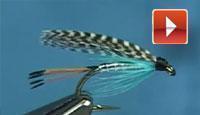










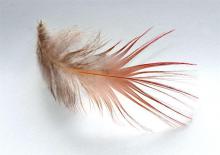





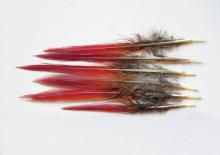

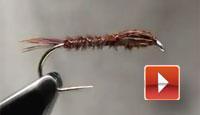
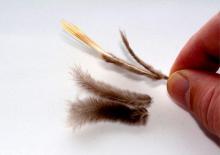
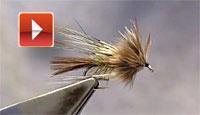








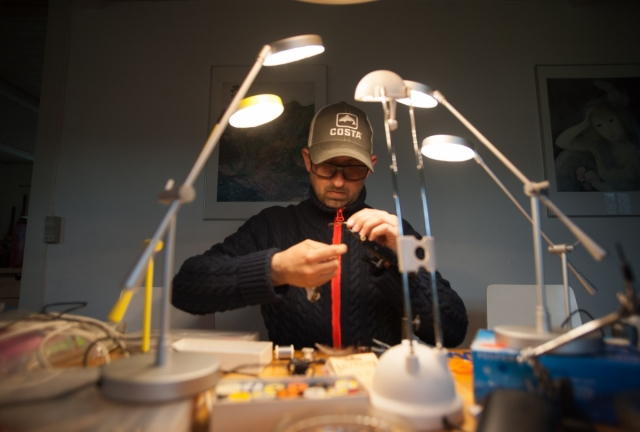















Comments
The green feathers o
The green feathers of the back can be use in the Fuzzy Wuzzy necklaces with green chenille body and otter hair with the hair as tail. Very good for fly fishing at Patagonia Argentina.
You can use the green feathers as ring neck in my Cicada pattern, with gray marabou from one red breast feather as tail, light brown chenille as body, gray dubbing as thorax. Very good for fly fishing at Patagonia in January.
Can use the brue feathers from the wings as wings on the beautiful wet fly Butcher or, I like more, the Bloody Butcher with a small red feather of breast as tail and beard. Can use the blue feathers as wing on a EVA Gum blue damselfly, a fly good for lakes at Patagonia too.
Can use the white and the brown biots of the wing in a Prince Nymph, with a small brown and red feather in the inside zone of the wing as ringneck.
With the marabou at the side of the yellow back feathers can tie a Damsel Nymph. A gray Damsel Nymph of course.
I tie a sea Shrimp with a side red feather as tail, orange chenille body and a side red feather as ringneck.
With the yellow feather tied in pukeko style can have a good caddis emerger, with green mohair yarn as body with the back of 3 fibers of brown ostrich and ribbing of copper.
With the tippet can have the legs in a caddis nymph.
I use red feathers of the breast in soft hackles too, just need to look for the small feathers and use size 12 hook.
With tail I do wingcases in gray Hare's Ear nymphs.
With the wing small brown feathers I do tails and hackles in without wings emergers with gray dubbing.
With the aftershaft I do the body in a soft nymph with marabou from a red or yellow feather ass tail and ribbing of copper.
With the marabou from a red feather I do the tail of my nymph, with 6 ostrich fibers in palmer as body with ribbing of copper, I use Chimango feather as wingcase but can use golden pheasant tail of turkey tail or other brown feather, fibers of the GP wing maybe will be good, and some gray dubbing as thorax, I use wildcat fur from an old coat.
From this article I think the Omoe Brush is the only fly you need to have when come at Patagonia, Argentina. Good to fishing at sea and in lakes and rivers. You'll notice that my shrimp is a variant of this.
Jan, I never hear
Jan,
I never heard of The Morton and Gold (or Silver). I can't find any references to it anywhere, and I haven't noticed Davie McPhail mentioning it either. I will check my books later today and see if I can find anything.
Martin
Martin, thanks fo
Martin,
thanks for your article about my favourite feathers-for-tying-giving bird. Do you have any clue about the Scottish fly Morton and Gold (or silver), mentioned by Davie McPhail as the only fly he knows using the feathers from the GP neck?
I am using it sometimes in the tail of "my" Golden Pheasant Shrimp.
Jan